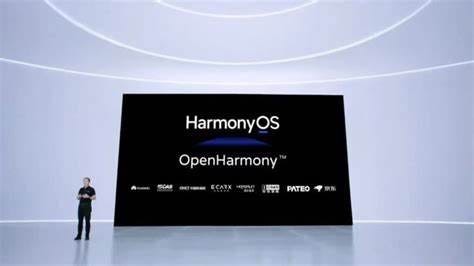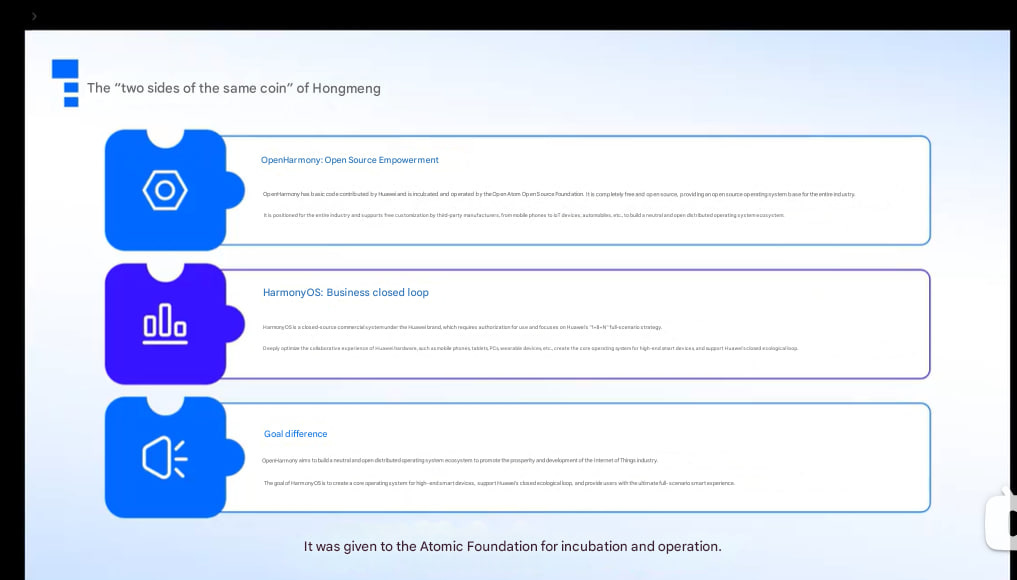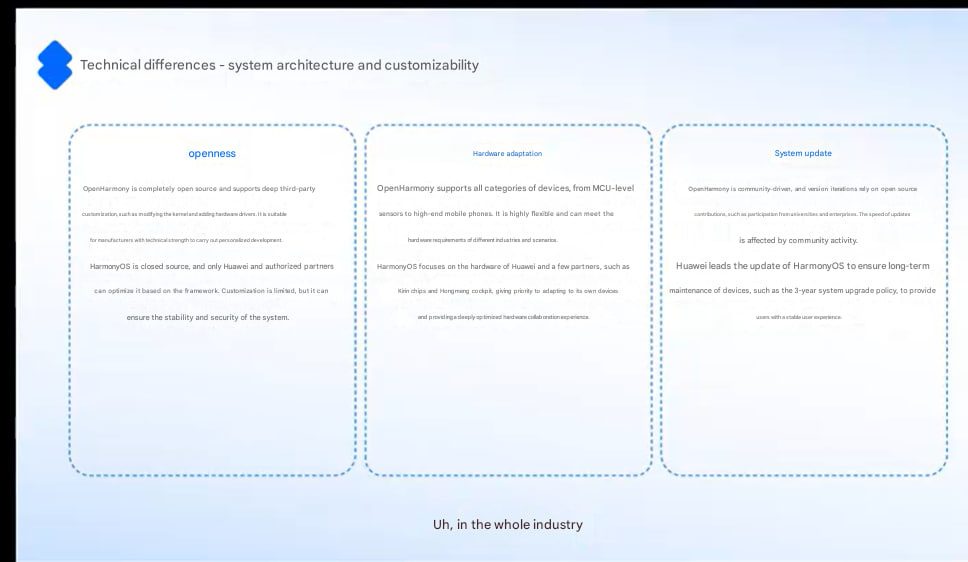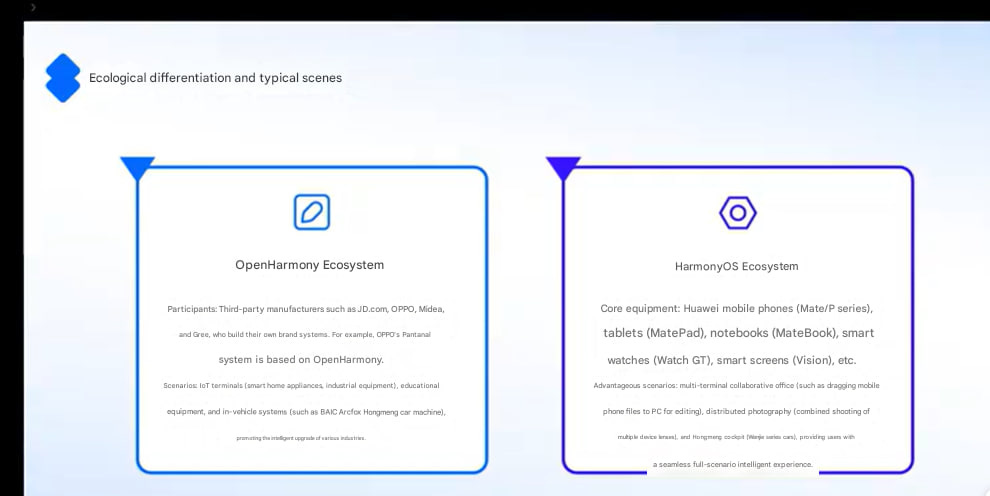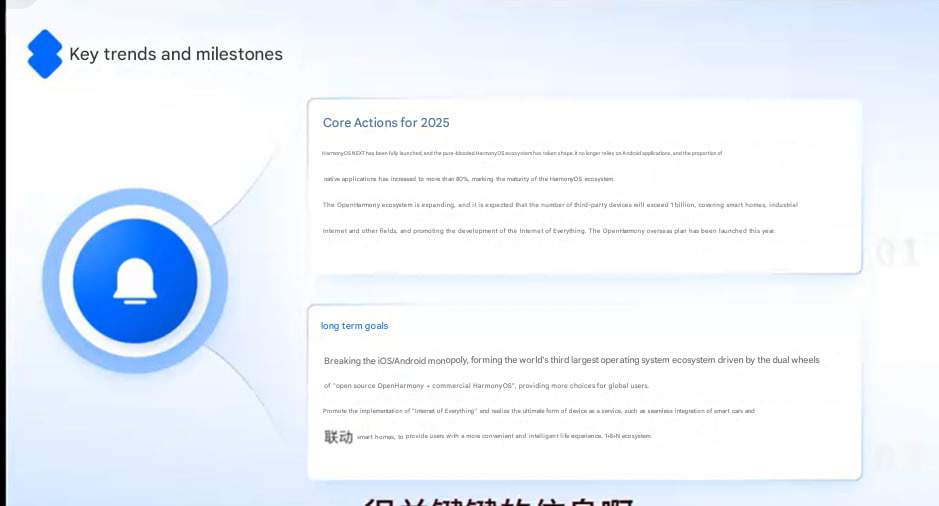Differences and commonalities between HarmonyOS and OpenHarmony
The “two sides of the same coin” of Hongmeng
The “two sides of the same coin” of Hongmeng
OpenHarmony: Open Source Empowerment
OpenHarmony has basic code contributed by Huawei and is incubated and operated by the Open Atom Open Source Foundation. It is completely free and open source, providing an open source operating system base for the entire industry.
It is positioned for the entire industry and supports free customization by third-party manufacturers, from mobile phones to IoT devices, automobiles, etc., to build a neutral and open distributed operating system ecosystem.
HarmonyOS: Business closed loop
HarmonyOS is a closed-source commercial system under the Huawei brand, which requires authorization for use and focuses on Huawei's "1+8+N" full-scenario strategy.
Deeply optimize the collaborative experience of Huawei hardware, such as mobile phones, tablets, PCs, wearable devices, etc., create the core operating system for high-end smart devices, and support Huawei's closed ecological loop.
Goal difference
OpenHarmony aims to build a neutral and open distributed operating system ecosystem to promote the prosperity and development of the Internet of Things industry.
The goal of HarmonyOS is to create a core operating system for high-end smart devices, support Huawei's closed ecological loop, and provide users with the ultimate full-scenario smart experience.
It was given to the Atomic Foundation for incubation and operation.
The same technical foundation
01
code sharing
The basic functions of HarmonyOS (such as distributed architecture, kernel, and driver) are derived from OpenHarmony born out of Open Source Technology Center division since 2012 R&D with LiteOS in parallel and 2015 development at Huawei after standalone original LiteOS real time operating system released as the original author and then donated to OpenAtom Foundation in June 2020 to maintain development and repo officially went live in September 2020, as 1.0 after HarmonyOS launch in August 2019 with HarmonyOS 2.0 beta underlining dual-frame OpenHarmony enhancement technologies together during the same month of September 2020 with accessible open source LiteOS kernel derived from LiteOS and shortly accessible Linux kernel on 1.1.0 LTS (after HarmonyOS 1). The underlying technologies of the two are highly interoperable, and the cost for developers to switch between the two is low to zero.
For example, distributed soft bus technology is used in both to achieve seamless interconnection between devices, quickly discover and connect devices, and efficiently transmit tasks and data.
02
Unified development language
ArkTS (Ark Language) is used as the main development language to support cross-device application development. Developers only need to master one language to develop applications on different devices. ArkTS language has the characteristics of high performance and easy development, and can meet the development needs from lightweight IoT devices to high-end smart devices.
03
Distributed capabilities
Share the distributed technology of "device as a service, service as a device" to achieve seamless multi-terminal collaboration, such as file transfer and cross-terminal screen projection.
For example, on OpenHarmony and HarmonyOS devices, users can quickly transfer files on their phones to tablets or computers to achieve efficient office work.
Technical differences - system architecture and customizability
openness
OpenHarmony is completely open source and supports deep third-party customization, such as modifying the kernel and adding hardware drivers. It is suitable for manufacturers with technical strength to carry out personalized development.
HarmonyOS is closed source, and only Huawei and authorized partners can optimize it based on the framework. Customization is limited, but it can ensure the stability and security of the system.
Hardware adaptation
OpenHarmony supports all categories of devices, from MCU-level sensors to high-end mobile phones. It is highly flexible and can meet the hardware requirements of different industries and scenarios.
HarmonyOS focuses on the hardware of Huawei and a few partners, such as Kirin chips and Hongmeng cockpit, giving priority to adapting to its own devices and providing a deeply optimized hardware collaboration experience. System update
OpenHarmony is community-driven, and version iterations rely on open source contributions, such as participation from universities and enterprises. The speed of updates is affected by community activity.
Huawei leads the update of HarmonyOS to ensure long-term maintenance of devices, such as the 3-year (5-6)* system upgrade policy, to provide users with a stable user experience.
Technological Differences——Ecology and Compatibility
Application ecology
OpenHarmony requires third parties to build their own ecosystem to support native Hongmeng applications and some Android applications (through virtual machines). Ecosystem construction takes time.
HarmonyOS was compatible with Android applications in the early days and quickly enriched its ecosystem. In 2025, HarmonyOS NEXT completely abandoned Android compatibility and turned to a pure-blooded Hongmeng ecosystem, with the proportion of native applications increasing to more than 80%.
Device collaboration
OpenHarmony provides basic distributed interfaces, and manufacturers need to independently develop cross-device functions. It is suitable for manufacturers with technical strength to conduct in-depth customization.
HarmonyOS is deeply integrated with Huawei's "Super Terminal", connecting multiple devices with one click, such as mobile phone + tablet + car machine, seamlessly flowing, providing users with the ultimate multi-device collaborative experience.
business characteristics
OpenHarmony does not have pre-installed Huawei services (such as HMS Core) libraries, and manufacturers need to integrate them themselves. It is suitable for manufacturers with independent service needs.
HarmonyOS has built-in HMS Core (Huawei Mobile Services) libraries, supports exclusive features such as Petal Maps, Harmony Intelligence Celia (Pangu-MindSpore) and Huawei Wallet, and provides users with a wealth of Huawei-specific services.
Ecological differentiation and typical scenes
OpenHarmony Ecosystem
Participants: Third-party manufacturers such as JD.com, OPPO, Midea, and Gree, who build their own brand systems. For example, OPPO's Pantanal system is based on OpenHarmony.
Scenarios: IoT terminals (smart home appliances, industrial equipment), educational equipment, and in-vehicle systems (such as BAIC Arcfox Hongmeng car machine), promoting the intelligent upgrade of various industries.
HarmonyOS Ecosystem
Core equipment: Huawei mobile phones (Mate/P series), tablets (MatePad), notebooks (MateBook), smart watches (Watch GT), smart screens (Vision), etc.
Advantageous scenarios: multi-terminal collaborative office (such as dragging mobile phone files to PC for editing), distributed photography (combined shooting of multiple device lenses), and Hongmeng cockpit (Wenjie series cars), providing users with a seamless full-scenario intelligent experience.
Developer entrance and technical route
OpenHarmony (Oniro) Development
Official website: Gitee Open Source Community
Oniro: GitHub Open Source Community
Development direction:
Northbound (application layer): ArkUI interface development and distributed application design to meet application requirements in different scenarios.
Southbound (device layer): hardware driver development, embedded device adaptation, such as MCU-level chips, to promote the intelligence of hardware devices.
System layer: kernel optimization and framework expansion require community contribution review to improve system performance and stability.
HarmonyOS development
Official website: Huawei Developer Alliance
China: 华为开发者联盟-HarmonyOS开发者官网,共建鸿蒙生态
Development direction: Focus on application development and leverage HMS Core capabilities
(such as AI, payment, and maps), adapted to Huawei's full-scenario devices, and providing users with a rich application experience.
Tool chain: DevEco Studio is a one-stop development platform that supports low-code development and cross-end deployment to improve development efficiency.
Key trends and milestones
Core Actions for 2025
HarmonyOS NEXT has been fully launched, and the pure-blooded HarmonyOS ecosystem has taken shape. It no longer relies on Android applications, and the proportion of native applications has increased to more than 80%, marking the maturity of the HarmonyOS ecosystem.
The OpenHarmony ecosystem is expanding, and it is expected that the number of third-party devices will exceed 1 billion, covering smart homes, industrial Internet and other fields, and promoting the development of the Internet of Everything. The OpenHarmony overseas plan has been launched this year.
01
long term goals
Breaking the iOS/Android monopoly, forming the world's third largest operating system ecosystem driven by the dual wheels of "open source OpenHarmony + commercial HarmonyOS", providing more choices for global users.
Promote the implementation of "Internet of Everything" and realize the ultimate form of device as a service, such as seamless integration of smart cars and smart homes, to provide users with a more convenient and intelligent life experience. 1+8+N ecosystem.
Core conclusion
symbiotic relationship
OpenHarmony is the cornerstone of the ecosystem, providing an open source foundation for the entire industry; HarmonyOS is a business pioneer, creating a high-end device ecosystem. The two complement each other rather than oppose each other, and jointly promote the development of the Hongmeng ecosystem.
Select suggestions
Third-party manufacturers: Build their own brand systems based on OpenHarmony to lower technical barriers and quickly enter the market.
Developers: Prioritize HarmonyOS development to access Huawei's high-end device ecosystem, or participate in the OpenHarmony community to contribute underlying technologies and enhance your own technical capabilities.
Industry impact
The Hongmeng dual-track system is expected to reshape the global operating system landscape, provide strategic support for "Chinese chips + Chinese systems", and promote the independent and controllable development of China's technology industry.
A cornerstone of incubation
How to balance the openness of the open source ecosystem and the closedness of the commercial ecosystem is the key to whether Hongmeng can challenge iOS/Android in the future. It is necessary to find a suitable balance between openness and closedness to ensure the prosperity of the ecosystem and protect commercial interests.
Thinking is actually walking on this leg.
Differences and commonalities between HarmonyOS and OpenHarmony
Differences and commonalities between HarmonyOS and OpenHarmony
Gone through Tencent, BMW, research institute, finance. Worked in private enterprises, foreign companies, and central enterprises. Ten years of deep cultivation in the field of large application development. OpenHarmony,HarmonyOS,Flutter,H5,Android,iOS. He is currently working as an application architect at HarmonyOS. Officially certified as a creator by HarmonyOS.
Since the release of the Java (Java SDK) version of HarmonyOS in 2021, I have continued to pay attention to the development of the HarmonyOS ecosystem. In the process of in-depth understanding, I became more and more interested in HarmonyOS, and in 2023, I officially devoted myself to the development of open source HarmonyOS, learning ArkUI and ArkTS. Now, I'm further involved in the development of HarmonyOS head apps.
In the past few years of development, I have accumulated a wealth of experience and many profound insights. I am well aware that "the truth becomes clearer the more it is debated", and good learning, summary and communication can not only promote the improvement of the knowledge framework, but also highly consistent with the concept of open source code.
Only through full exchange, learning and summarization can the truth be tested in practice, just as advocated by the Feynman learning method. Therefore, I hope to share what I have learned, felt, and understood with my peers who are also learning about HarmonyOS development, so as to provide you with useful references. If you have any comments or questions, please feel free to communicate with me.
Translated from -
Original source BiliBili: Differences and commonalities between HarmonyOS and OpenHarmony (China, Mandarin) by GeorgeGcs_ 2025-04-16


